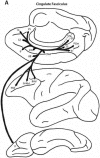The cortical connectivity of the prefrontal cortex in the monkey brain
- PMID: 21481342
- PMCID: PMC3161133
- DOI: 10.1016/j.cortex.2011.03.004
The cortical connectivity of the prefrontal cortex in the monkey brain
Abstract
One dimension of understanding the functions of the prefrontal cortex is knowledge of cortical connectivity. We have surveyed three aspects of prefrontal cortical connections: local projections (within the frontal lobe), the termination patterns of long association (post-Rolandic) projections, and the trajectories of major fiber pathways. The local connections appear to be organized in relation to dorsal (hippocampal origin) and ventral (paleocortical origin) architectonic trends. According to the proposal of a dual origin of the cerebral cortex, cortical areas can be traced as originating from archicortex (hippocampus) on the one hand, and paleocortex, on the other hand, in a stepwise manner (e.g., Sanides, 1969; Pandya and Yeterian, 1985). Prefrontal areas within each trend are connected with less architectonically differentiated areas, and also with more differentiated areas. Such organization may allow for the systematic exchange of information within each architectonic trend. The long connections of the prefrontal cortex with post-Rolandic regions seem to be organized preferentially in relation to dorsal and ventral prefrontal architectonic trends. Prefrontal areas are connected with post-Rolandic auditory, visual and somatosensory association areas, and with multimodal and paralimbic regions. This long connectivity likely works in conjunction with local connections to serve prefrontal cortical functions. The afferent and efferent connections of the prefrontal cortex with post-Rolandic regions are conveyed by specific long association pathways. These pathways as well appear to be organized in relation to dorsal and ventral prefrontal architectonic trends. Finally, although prefrontal areas have preferential connections in relation to dual architectonic trends, it is clear that there are interconnections between and among areas in each trend, which may provide a substrate for the overall integrative function of the prefrontal cortex. Prefrontal corticocortical connectivity may help to elucidate both region-specific and integrative perspectives on the functions of the prefrontal cortex.
Copyright © 2011 Elsevier Srl. All rights reserved.
Figures


























References
-
- Andersen RA, Asanuma C, Cowan WM. Callosal and prefrontal associational projecting cell populations in area 7A of the macaque monkey: A study using retrogradely transported fluorescent dyes. Journal of Comparative Neurology. 1985;232(4):443–455. - PubMed
-
- Andersen RA, Asanuma C, Essick G, Siegel RM. Corticocortical connections of anatomically and physiologically defined subdivisions within the inferior parietal lobule. Journal of Comparative Neurology. 1990;296(1):65–113. - PubMed
-
- Arikuni T, Watanabe K, Kubota K. Connections of area 8 with area 6 in the brain of the macaque monkey. Journal of Comparative Neurology. 1988;277(1):21–40. - PubMed
-
- Arikuni T, Sako H, Murata A. Ipsilateral connections of the anterior cingulate cortex with the frontal and medial temporal cortices in the macaque monkey. Neuroscience Research. 1994;21(1):19–39. - PubMed
-
- Bachevalier J, Meunier M, Lu MX, Ungerleider LG. Thalamic and temporal cortex input to medial prefrontal cortex in rhesus monkeys. Experimental Brain Research. 1997;115(3):430–444. - PubMed
Publication types
MeSH terms
Grants and funding
LinkOut - more resources
Full Text Sources

